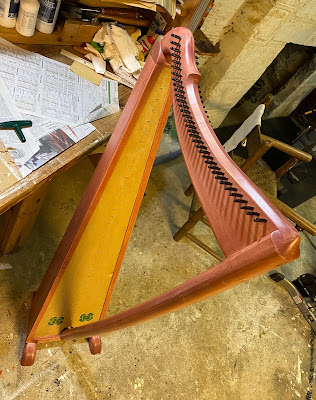When I first read the description of the new Ballad harp from Musicmakers, I was a little dismayed. It featured a lighter tension and closer spacing of the strings. I thought, 'How irritating.' Also, I had already made two harps and what did I need with another? That was in the spring.
Over the summer, I joined the Bright Knowledge Harp Circle and began the wonderful adventure of a deeper dive into playing the harp. I realized there were all kinds of possibilities for improving my playing and clarifying my expression. Also, I had experienced several more months of living with a raging pandemic and, well, rage in general. It occurred to me that having a lighter, more sensitive touch might be good in today's world--we could use a little more yin to balance the yang being thrown about. So, when there was a deal I couldn't refuse, I ordered the DIY Ballad Kit from Musicmakers. It arrived a couple of days later.
I knew what I would name my new harp long before she arrived unassembled: Clover. That is not a surprise to those of you who know me. I love clover and learned from Carly-the-Dog to spot 4-leafs. My dream lakeside studio was called Clover Slope. But, clover, the plant, does not need my endorsement. This humble little plant is a wonder! Of course it is charming above ground, with a sweet scent when abundantly in bloom and the leaves, whether in 3s, 4s or more are so pleasing in their simple way. Below ground, clover is quite industrious, fixing nitrogen in the soil so that it is accessible to vegetation. And, generally, clover comes to us as a grace. I included two four leafs on the soundboard to proclaim Clover's identity.

Working on Clover, I remembered the challenges and delights of building an instrument. I highly recommend Musicmakers kits. I built my first harp with no previous woodworking experience. Clover is my fifth instrument and so I knew more, but I forget things in between and always learn something new with each project. This time, I learned about orbital sanders--they save a lot of time! Still, building a harp is quite a yang exercise. There is a lot of brute force and endurance involved. I was looking forward to practicing some yin-action!





No comments:
Post a Comment